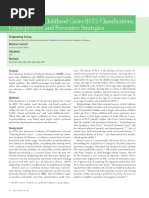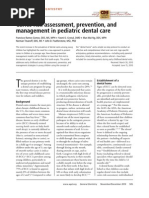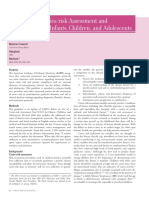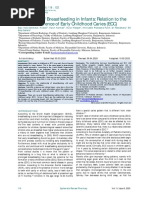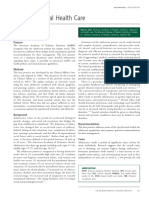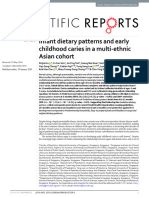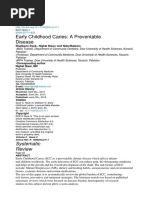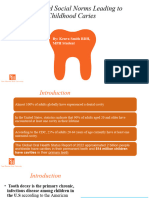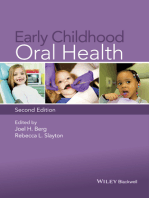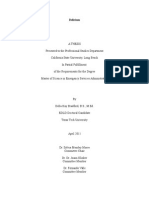ECC Classifications
ECC Classifications
Uploaded by
N MachaCopyright:
Available Formats
ECC Classifications
ECC Classifications
Uploaded by
N MachaCopyright
Available Formats
Share this document
Did you find this document useful?
Is this content inappropriate?
Copyright:
Available Formats
ECC Classifications
ECC Classifications
Uploaded by
N MachaCopyright:
Available Formats
AMERICAN ACADEMY OF PEDIATRIC DENTISTRY
Policy on Early Childhood Caries (ECC): Classifications,
Consequences, and Preventive Strategies
Review Council
Council on Clinical Affairs
Latest Revision
2016
Purpose ECC is defined as the presence of one or more decayed
Early childhood caries (ECC), formerly referred to as nursing (noncavitated or cavitated lesions), missing (due to caries), or
bottle caries and baby bottle tooth decay, remains a signifi- filled tooth surfaces in any primary tooth in a child under the
cant public health problem.1 The American Academy of age of six. The definition of severe early childhood caries
Pediatric Dentistry (AAPD) encourages healthcare providers (S-ECC) is any sign of smooth-surface caries in a child
and caregivers to implement preventive practices that can younger than three years of age, and from ages three through
decrease a child’s risks of developing this disease. five, one or more cavitated, missing (due to caries), or filled
smooth surfaces in primary maxillary anterior teeth or a de-
Methods cayed, missing, or filled score of greater than or equal to four
This policy was originally developed in a collaborative effort (age 3), greater than or equal to five (age 4), or greater than
of the American Academy of Pedodontics and the American or equal to six (age 5).4
Academy of Pediatrics, and adopted in 1978. This document Epidemiologic data from a 2011-2012 national survey
is a revision of the previous version, last revised by the AAPD clearly indicate that ECC remains highly prevalent in poor and
in 2014. The update used electronic and hand searches of near poor U.S. preschool children. For the overall population
English written articles in the dental and medical literature of preschool children, the prevalence of ECC, as measured by
within the last 10 years, using the search terms infant oral decayed and filled tooth surfaces (dfs), is unchanged from
health, infant oral health care, and early childhood caries. previous surveys, but the filled component (fs) has greatly
Recent references to ECC, along with full text, can be found increased indicating that more treatment is being provided.5
on the Early Childhood Caries Resource Center database The consequences of ECC often include a higher risk of new
(http://earlychildhoodcariesresourcecenter.elsevier.com). When carious lesions in both the primary and permanent denti-
information from these articles did not appear sufficient or tions, 6,7 hospitalizations and emergency room visits, 8,9 high
was inconclusive, policies were based upon expert and con- treatment costs,10 loss of school days,11 diminished ability to
sensus opinion by experienced researchers and clinicians. learn,12 and diminished oral health-related quality of life.13
Microbial risk markers for ECC include MS and Lacto-
Background bacillus species.14 However, new tools for bacterial identifi-
In 1978, the American Academy of Pedodontics and the cation (e.g., polymerase chain reaction [PCR] techniques, 16s
American Academy of Pediatrics released a joint statement rRNA gene sequencing) are revealing the complexity of the oral
“Juice in Ready-to-Use Bottles and Nursing Bottle Caries” to microbiome and other bacterial species that may be associated
address a severe form of caries associated with bottle usage.2 with ECC.15 MS maybe transmitted vertically from caregiver
Initial policy recommendations were limited to feeding habits, to child through salivary contact, affected by the frequency
concluding that nursing bottle caries could be avoided if bottle and amount of exposure.16 Infants whose mothers have high
feedings were discontinued soon after the first birthday. An levels of MS, a result of untreated caries, are at greater risk
early policy revision added ad libitum breast-feeding as a of acquiring the organism earlier than children whose mothers
causative factor. Over the next two decades, however, recog- have low levels.17 Horizontal transmission (e.g., between other
nizing that ECC was not solely associated with poor feeding members of a family or children in daycare) also occurs.17
practices, AAPD adopted the term ECC to better reflect its
multi-factoral etiology. These factors include susceptible teeth
ABBREVIATIONS
due to enamel hypoplasia, oral colonization with elevated levels
AAPD: American Academy Pediatric Dentistry. ECC: Early child-
of cariogenic bacteria, especially Mutans Streptococci (MS), hood caries. MS: Mutans streptococci. PCR: Polymerase chain
and the metabolism of sugars by tooth-adherent bacteria to reaction. S-ECC: Severe early childhood Caries.
produce acid which, over time, demineralizes tooth structure.3
ORAL HE ALTH POLICIES 59
REFERENCE MANUAL V 39 / NO 6 17 / 18
An associated risk factor to microbial etiology is high con- Evidence increasingly suggests that preventive interven-
sumption of sugars. 18 Caries-conducive dietary practices tions within the first year of life are critical. 31 This may be
appear to be established by 12 months of age and are main- best implemented with the help of medical providers who, in
tained throughout early childhood. 19 Frequent nighttime many cases, are being trained to provide oral screenings, apply
bottle-feeding with milk and ad libitum breast-feeding are preventive measures, counsel caregivers, and refer infants and
associated with, but not consistently implicated in, ECC.20 toddlers for dental care.32
Night time bottle feeding with juice, repeated use of a sippy
or no-spill cup, and frequent in-between meal consumption of Policy statement
sugar-added snacks or drinks (e.g., juice, formula, soda) in- The AAPD recognizes early childhood caries as a significant
crease the risk of caries.21 While ECC may not arise from breast chronic disease resulting from an imbalance of multiple risk
milk alone, breast-feeding in combination with other carbohy- and protective factors over time. To decrease the risk of devel-
drates has been found in vitro to be highly cariogenic.22 Frequent oping ECC, the AAPD encourages professional and at-home
consumption of between-meal snacks and beverages containing preventive measures that include:
sugars increases the risk of caries due to prolonged contact 1. Avoiding frequent consumption of liquids and/or solid
between sugars in the consumed food or liquid and cariogenic foods containing sugar, in particular:
bacteria on the susceptible teeth.23 The American Academy of • Sugar-sweetened beverages (e.g., juices, soft drinks,
Pediatrics has recommended that infants should not be given sports drinks, sweetened tea) in a baby bottle or
juice from bottles or covered cups that allow them to consume no-spill training cup.
juice throughout the day, and intake of 100 percent fruit juice • Ad libitum breast-feeding after the first primary tooth
should be limited to no more than four to six ounces per day begins to erupt and other dietary carbohydrates are
for children one through six years old.24 Additionally, newly- introduced.
erupted teeth, because of immature enamel, and teeth with • Baby bottle use after 12-18 months.
enamel hypoplasia may be at higher risk of developing caries.25 2. Implementing oral hygiene measures no later than the
Current best practice to reduce the risk of ECC includes time of eruption of the first primary tooth. Toothbrush-
twice-daily brushing with fluoridated toothpaste for all chil- ing should be performed for children by a parent twice
dren in optimally-fluoridated and fluoride-deficient commu- daily, using a soft toothbrush of age-appropriate size.
nities.26,27 When determining the risk-benefit of fluoride, the In children under the age of three, a smear or rice-sized
key issue is mild fluorosis versus preventing dental disease. A amount of fluoridated toothpaste should be used. In
smear or rice-sized amount of fluoridated toothpaste children ages three to six, a pea-sized amount of fluori-
(approximately 0.1 mg fluoride; see Figure) should be used dated toothpaste should be used.
for children less than three years of age. A pea-sized amount 3. Providing professionally-applied fluoride varnish treat-
of fluoridated toothpaste (approximately 0.25 mg fluoride) is ments for children at risk for ECC.
appropriate for children aged three to six. 28 Parents should 4. Establishing a dental home within six months of erup-
dispense the toothpaste onto a soft, age-appropriate sized tion of the first tooth and no later than 12 months of age
toothbrush and perform or assist with toothbrushing of to conduct a caries risk assessment and provide parental
preschool-aged children. To maximize the beneficial effect of education including anticipatory guidance for prevention
fluoride in the toothpaste, rinsing after brushing should be of oral diseases.
kept to a minimum or eliminated altogether.29 5. Working with medical providers to ensure all infants and
Professionally-applied topical fluoride treatments also are toddlers have access to dental screenings, counseling, and
efficacious in reducing prevalence of ECC. The recommended preventive procedures.
professionally-applied fluoride treatments for children at risk 6. Educating legislators, policy makers, and third party
for ECC who are younger than six years is five percent so- payors regarding the consequences of and preventive
dium fluoride varnish (NaFV; 22,500 ppm F).30 strategies for ECC.
References
Smear – under 3 yrs. Pea-sized – 3 to 6 yrs.
1. Proceedings of the conference: Innovations in the pre-
vention and management of early childhood caries.
Pediatr Dent 2015;37(3):198-9.
2. American Academy of Pediatrics, American Academy of
Pedodontics. Juice in ready-to-use bottles and nursing
bottle caries. AAP News and Comment 1978;29(1):11.
3. Tinanoff N. Introduction to the conference: Innovations
in the prevention and management of early childhood
Figure. Comparison of a smear (left) with a pea-sized (right) amount caries. Pediatr Dent 2015;37(4):198-9.
of toothpaste.
60 ORAL HE ALTH POLICIES
AMERICAN ACADEMY OF PEDIATRIC DENTISTRY
4. Drury TF, Horowitz AM, Ismail AI, et al. Diagnosing 20. Reisine S, Douglass JM. Psychosocial and behavioral is-
and reporting early childhood caries for research pur- sues in early childhood caries. Comm Dent Oral Epidem
poses. J Public Health Dent 1999;59(3):192-7. 1998;26(suppl 1):32-44.
5. Dye BA, Hsu K-L, Afful J. Prevalence and measurement 21. Tinanoff NT, Kanellis MJ, Vargas CM. Current under-
of dental caries in young children. Pediatr Dent 2015; standing of the epidemiology mechanism, and preven-
37(3):200-16. tion of dental caries in preschool children. Pediatr Dent
6. O’Sullivan DM, Tinanoff N. The association of early 2002;24(6):543-51.
childhood caries patterns with caries incidence in pre- 22. Erickson PR, Mazhari E. Investigation of the role of hu-
school children. J Public Health Dent 1996;56(2):81-3. man breast milk in caries development. Pediatr Dent
7. Al-Shalan TA, Erickson PR, Hardie NA. Primary inci- 1999;21(2):86-90.
sor decay before age 4 as a risk factor for future dental 23. Tinanoff NT, Palmer C. Dietary determinants of dental
caries. Pediatr Dent 1997;19(1):37-41. caries in preschool children and dietary recommenda-
8. Ladrillo TE, Hobdell MH, Caviness C. Increasing preval- tions for preschool children. J Pub Health Dent 2000;
ence of emergency department visits for pediatric dental 60(3):197-206.
care 1997-2001. J Am Dent Assoc 2006;137(3):379-85. 24. American Academy of Pediatrics Committee on Nutri-
9. Griffin SO, Gooch BF, Beltran E, Sutherland JN, Barsley tion. Policy statement: The use and misuse of fruit juices
R. Dental services, costs, and factors associated with in pediatrics. Pediatrics 2001;107(5):1210-3. Reaffirmed
hospitalization for Medicaid-eligible children, Louisiana October, 2006.
1996-97. J Public Health Dent 2000;60(3):21-7. 25. Caufield PW, Li Y, Bromage TG. Hypoplasia-associated
10. Agency for Healthcare Research and Quality. Total den- severe early childhood caries: A proposed definition. J
tal care expenditure, 2010, Medical Expenditure Panel Dent Res 2012;91(6):544-50.
Survey. Available at: “http://meps.ahrq.gov/mepsweb/ 26. Santos AP, Oliveira BH, Nadanovsky P. Effects of low
data_files/publications/st415/stat415.pdf.” Accessed April and standard fluoride toothpastes on caries and fluorosis:
®
9, 2015. (Archived by WebCite at: “http://www.webcita
tion.org/6XezI3w7Y”). Accessed April 9, 2015.
Systematic review and meta-analysis. Caries Res 2013;
47(5):382-90.
11. Edelstein BL, Reisine S. Fifty-one million: A mythical 27. American Dental Association Council on Scientific
number that matters. J Am Dent Assoc 2015;146(8): Affairs. Fluoride toothpaste use for young children. J
565-6. Am Dent Assoc 2014;145(2):190-1.
12. Blumenshine SL, Vann WF, Gizlice Z, Lee JY. Children’s 28. Wright JT, Hanson N, Ristic H, Whall CW, Estrich
school performance: Impact of general and oral health. CG, Zentz RR. Fluoride toothpaste efficacy and safety
J Public Health Dent 2008;68(2):82-7. in children younger than 6 years. J Am Dent Assoc 2014;
13. Filstrup SL, Briskie D, daFonseca M, Lawrence L, Wandera 145(2):182-9.
A, Inglehart MR. The effects on early childhood caries 29. Sjögren K, Birkhed D. Factors related to fluoride reten-
(ECC) and restorative treatment on children’s oral health- tion after toothbrushing and possible connection to
related quality of life (OHRQOL). Pediatr Dent 2003; caries activity. Caries Res 1993;27(6):474-7.
25(5):431-40. 30. Weyant RJ, Tracy SL, Anselmo T, Beltrán-Aguilar EJ,
14. Kanasi E, Johansson J, Lu SC, et al. Microbial risk mark- Donly KJ, Frese WA. Topical fluoride for caries pre-
ers for childhood caries in pediatrician’s offices. J Dent vention: Executive summary of the updated clinical rec-
Res 2010;89(4):378-83. ommendations and supporting systematic review. J Am
15. Li Y, Tanner A. Effect of antimicrobial interactions on Dent Assoc 2013;144(11):1279-91.
the oral microbiota associated with early childhood 31. Lee JY, Bouwens TJ, Savage MF, Vann WF. Examining
caries. Pediatr Dent 2015;37(3):226-44. the cost-effectiveness of early dental visits. Pediatr Dent
16. Li Y, Caufield PW. The fidelity of initial acquisition of 2006;28(2):102-105, discussion 192-8.
mutans streptococci by infants from their mothers. J 32. Douglass AB, Douglass JM, Krol DM. Educating pedi-
Dent Res 1995;74(2):681-5. atricians and family physicians in children’s oral health.
17. Berkowitz RJ. Mutans streptococci: Acquisition and Academic Pediatr 2009;9(6):452-6.
transmission. Pediatr Dent 2006;28(2):106-9.
18. Moynihan PJ, Kelly SAM. Effect on caries of restricting
sugars intake: Systematic review to inform WHO guide-
lines. J Dent Res 2014;93(1):8-18.
19. Kranz S, Smiciklas-Wright H, Francis LA. Diet quality,
added sugar, and dietary fiber intake in American pre-
schoolers. Pediatr Dent 2006;28(2)164-71.
ORAL HE ALTH POLICIES 61
You might also like
- Infusion Therapy Standards of Practice, 9th.1Document291 pagesInfusion Therapy Standards of Practice, 9th.1Luis MendezNo ratings yet
- Grade 11 Academic Math Textbook OntarioDocument3 pagesGrade 11 Academic Math Textbook OntarioEllenNo ratings yet
- UTI - Concept MapDocument1 pageUTI - Concept MapZam Pamate100% (4)
- Guided ConversationDocument25 pagesGuided ConversationMend HannNo ratings yet
- Making Health PolicyDocument213 pagesMaking Health PolicyNurhikmah Rn100% (4)
- Policy On Early Childhood Caries (ECC) : Classifications, Consequences, and Preventive StrategiesDocument4 pagesPolicy On Early Childhood Caries (ECC) : Classifications, Consequences, and Preventive Strategiesrahul sharmaNo ratings yet
- Caries Temprana de La InfanciaDocument6 pagesCaries Temprana de La InfanciaAna CristernaNo ratings yet
- Policy On Early Childhood Caries ECC: Consequences and Preventive StrategiesDocument4 pagesPolicy On Early Childhood Caries ECC: Consequences and Preventive StrategiesCesar Loyola SanchezNo ratings yet
- Early Childhood Caries ClassificationDocument3 pagesEarly Childhood Caries ClassificationAnkita Arora100% (1)
- G Infantoralhealthcare PDFDocument5 pagesG Infantoralhealthcare PDFBanyu علي تقويم BiruNo ratings yet
- G InfantoralhealthcareDocument5 pagesG InfantoralhealthcareMiranda PCNo ratings yet
- 5 Klasisifikasi ECCDocument3 pages5 Klasisifikasi ECCSusi AbidinNo ratings yet
- G PerinatalOralHealthCare1Document5 pagesG PerinatalOralHealthCare1perla edith bravoNo ratings yet
- Guía Infant Oral Health CareDocument5 pagesGuía Infant Oral Health Careximena mirandaNo ratings yet
- Caries Risk AssessmentDocument13 pagesCaries Risk AssessmentLucia ArguelloNo ratings yet
- Guideline On Caries-Risk Assessment and Management For Infants, Children, and AdolescentsDocument8 pagesGuideline On Caries-Risk Assessment and Management For Infants, Children, and AdolescentsPriscila Belén Chuhuaicura SotoNo ratings yet
- Caries Risk AssessmentDocument8 pagesCaries Risk AssessmentGrace Shabrina HapsariNo ratings yet
- Early Childhood Caries (ECC) : Allison Restauri, RDH, BSDH EDU 653 1 1 - 0 3 - 2 0 1 2Document25 pagesEarly Childhood Caries (ECC) : Allison Restauri, RDH, BSDH EDU 653 1 1 - 0 3 - 2 0 1 2Justforkiddslaserdental ChNo ratings yet
- Fichas de Trabajo - Caries Temprana de La Infancia.Document19 pagesFichas de Trabajo - Caries Temprana de La Infancia.Erick Luna RojasNo ratings yet
- Guideline On Caries-Risk Assessment and Management For Infants, Children, and AdolescentsDocument8 pagesGuideline On Caries-Risk Assessment and Management For Infants, Children, and AdolescentsAkaul RukchonNo ratings yet
- Maternal Caries Experience Influences Offspring's Early Childhood Caries-A Birth Cohort StudyDocument9 pagesMaternal Caries Experience Influences Offspring's Early Childhood Caries-A Birth Cohort StudyAkhila ReddyNo ratings yet
- FDX 184Document9 pagesFDX 184André FonsecaNo ratings yet
- Jurnal 17 Scopus Q2 A Review of Breastfeeding in InfantsDocument7 pagesJurnal 17 Scopus Q2 A Review of Breastfeeding in Infantshuldani-1No ratings yet
- Caries Experience, Mutans Streptococci and Total ProteinDocument8 pagesCaries Experience, Mutans Streptococci and Total Proteintrueblueimmigration85No ratings yet
- Guideline On Caries-Risk Assessment and Management For Infants, Children, and AdolescentsDocument8 pagesGuideline On Caries-Risk Assessment and Management For Infants, Children, and AdolescentsShruti SoodNo ratings yet
- Guideline On Perinatal Oral Health Care: Originating Council AdoptedDocument5 pagesGuideline On Perinatal Oral Health Care: Originating Council AdoptedFer Panda Vr RmNo ratings yet
- Early Childhood CariesDocument31 pagesEarly Childhood CariesPauline MagpantayNo ratings yet
- Jurnal Faktor Resiko Ramapan Karies AnakDocument9 pagesJurnal Faktor Resiko Ramapan Karies AnakSuyatmiNo ratings yet
- Breastfeeding and The Risk of Dental Caries: A Systematic Review and Meta-AnalysisDocument23 pagesBreastfeeding and The Risk of Dental Caries: A Systematic Review and Meta-AnalysisSusi susiNo ratings yet
- NIH Public Access: Pediatric Dental Care: Prevention and Management Protocols Based On Caries Risk AssessmentDocument21 pagesNIH Public Access: Pediatric Dental Care: Prevention and Management Protocols Based On Caries Risk AssessmentRahmi Julianti HarahapNo ratings yet
- Ingles Caries de La Primera InfanciaDocument14 pagesIngles Caries de La Primera InfanciaISABELANo ratings yet
- Oral Health in Children - Guidelines For PediatriciansDocument5 pagesOral Health in Children - Guidelines For PediatriciansAbdul Ghaffar AbdullahNo ratings yet
- Infant Oral Health CareDocument16 pagesInfant Oral Health CareAJPEDO LIFE100% (1)
- Bijcrid 20221103Document5 pagesBijcrid 20221103BOHR International Journal of Current research in Dentistry (BIJCRID)No ratings yet
- Document (7) 1Document76 pagesDocument (7) 1panditabhi123456789No ratings yet
- G PerinataloralhealthcareDocument6 pagesG PerinataloralhealthcareRosa WillisNo ratings yet
- Early Childhood Caries: Etiology, Clinical Considerations, Consequences and ManagementDocument8 pagesEarly Childhood Caries: Etiology, Clinical Considerations, Consequences and ManagementPetrChalupaNo ratings yet
- Anticipatory Guidance in Pediatric Dentistry: Cite This PaperDocument6 pagesAnticipatory Guidance in Pediatric Dentistry: Cite This PaperAmanda HuggetNo ratings yet
- Critical Review Ecc 2004Document12 pagesCritical Review Ecc 2004Susi AbidinNo ratings yet
- Oral Hygiene & Health: Early Childhood Caries: A Literature ReviewDocument7 pagesOral Hygiene & Health: Early Childhood Caries: A Literature ReviewlarisaNo ratings yet
- PerinataloralhealthcareDocument5 pagesPerinataloralhealthcareManar ShawdaryNo ratings yet
- Adolescent Oral Health Care: Latest RevisionDocument10 pagesAdolescent Oral Health Care: Latest RevisionYemna NsiriNo ratings yet
- More Milk, Stronger Teeth? (Part I)Document4 pagesMore Milk, Stronger Teeth? (Part I)Nicole StoicaNo ratings yet
- The Prevalence of Early Childhood CariesDocument6 pagesThe Prevalence of Early Childhood Cariesvirgínia oliveiraNo ratings yet
- Infante y Perinatal AppdDocument5 pagesInfante y Perinatal AppdandreaNo ratings yet
- Causes, Treatment and Prevention of Early Childhood Caries: A Microbiologic PerspectiveDocument10 pagesCauses, Treatment and Prevention of Early Childhood Caries: A Microbiologic Perspectiverahul sharmaNo ratings yet
- HSPartners TinanoffDocument29 pagesHSPartners TinanoffbayuNo ratings yet
- South University Tampa PA Interview Article PDFDocument6 pagesSouth University Tampa PA Interview Article PDFsteinway007No ratings yet
- Breastfeeding and Dental Caries. Review of The Literature.: Geanina Besliu - Rosu OanaDocument12 pagesBreastfeeding and Dental Caries. Review of The Literature.: Geanina Besliu - Rosu OanaAnamaria RagoscaNo ratings yet
- Infant Oral Health and Ant - GuidanceDocument53 pagesInfant Oral Health and Ant - GuidanceSonam RawatNo ratings yet
- Guideline On Caries-Risk Assessment and Management For Infants, Children, and AdolescentsDocument8 pagesGuideline On Caries-Risk Assessment and Management For Infants, Children, and AdolescentsPriscila Belén Chuhuaicura SotoNo ratings yet
- Caries Risk Assessment, Cariogram, Caries VaccineDocument35 pagesCaries Risk Assessment, Cariogram, Caries VaccineUmaima Khan0% (3)
- Infant Dietary Patterns and Early Childhood Caries in A Multi-Ethnic Asian CohortDocument8 pagesInfant Dietary Patterns and Early Childhood Caries in A Multi-Ethnic Asian CohortRasciusNo ratings yet
- AAPD Caries Risk Management For InfantsDocument9 pagesAAPD Caries Risk Management For InfantsDulce MartinezNo ratings yet
- Dietary Counseling and Education in Preventive Dentistry: PreventionDocument8 pagesDietary Counseling and Education in Preventive Dentistry: PreventionHaider F YehyaNo ratings yet
- Early Childhood CariesDocument13 pagesEarly Childhood Cariesrahul sharmaNo ratings yet
- C0131261317 PDFDocument5 pagesC0131261317 PDFrifkiNo ratings yet
- Riesgo de Caries OdontopediatriaDocument8 pagesRiesgo de Caries OdontopediatriaAlexandraPortugalInfantasNo ratings yet
- Dental Caries and Oral Health Related Quality of Life of 3 Year Olds Living in Lima PeruDocument10 pagesDental Caries and Oral Health Related Quality of Life of 3 Year Olds Living in Lima PerunursyamsiNo ratings yet
- AAPD, 2014, Guideline On Caries-Risk Assessment and Management For Infant, Children, and AdolescentDocument8 pagesAAPD, 2014, Guideline On Caries-Risk Assessment and Management For Infant, Children, and AdolescentRafi Kusuma Ramdhan SukonoNo ratings yet
- Habits and Social Norms Leading To Childhood CariesDocument19 pagesHabits and Social Norms Leading To Childhood Cariesapi-522555065No ratings yet
- Early Childhood CariesDocument44 pagesEarly Childhood CariesAnisha DanoleNo ratings yet
- Art 3A10.1186 2F1471 2458 10 97Document10 pagesArt 3A10.1186 2F1471 2458 10 97Jhonatan Enso A CNo ratings yet
- Snack and ToothbrushingDocument8 pagesSnack and Toothbrushingsandra del pilarNo ratings yet
- Pe 11Document2 pagesPe 11rheyNo ratings yet
- Narrative of Dry Run SimulationDocument2 pagesNarrative of Dry Run SimulationJhen SalamatNo ratings yet
- Statement Dated 2023-05-10Document13 pagesStatement Dated 2023-05-10Logan casillasNo ratings yet
- MODULE 6 Supplement APRIL 2018 PDFDocument3 pagesMODULE 6 Supplement APRIL 2018 PDFEryll Paolo AleaNo ratings yet
- Pediatric Nursing: Narayan Swami College of NursingDocument10 pagesPediatric Nursing: Narayan Swami College of NursingAnkit KotnalaNo ratings yet
- LUTS Assessment LURN Symptom IndexDocument17 pagesLUTS Assessment LURN Symptom IndexOmar Salim AkhtarNo ratings yet
- Toc PDFDocument9 pagesToc PDFKritika P SoroutNo ratings yet
- Spotlight 14 Good Vibrations Students' Well BeingDocument12 pagesSpotlight 14 Good Vibrations Students' Well BeingIntan EdufunNo ratings yet
- Amalgam War - 110301066Document16 pagesAmalgam War - 110301066Vishesh JainNo ratings yet
- Marikina RHU For ADB PDFDocument26 pagesMarikina RHU For ADB PDFKristine PresbiteroNo ratings yet
- Adherence in Pediatric Kidney Transplant RecipientsDocument12 pagesAdherence in Pediatric Kidney Transplant RecipientsLuciana SampaioNo ratings yet
- DAY 16 ANIMAL TESTING Ielts NguyenhuyenDocument1 pageDAY 16 ANIMAL TESTING Ielts NguyenhuyenAn QuanNo ratings yet
- Title: How Climate Change Could Make Our Food Less Nutritious By: Kristen EbiDocument5 pagesTitle: How Climate Change Could Make Our Food Less Nutritious By: Kristen EbiMonica InoiNo ratings yet
- Bullying and Ostracism Experiences in Children - JDBPDocument9 pagesBullying and Ostracism Experiences in Children - JDBPAndreea Gligor100% (1)
- PHD ThesisDocument74 pagesPHD ThesisEngrAbeer ArifNo ratings yet
- Lung AbscessDocument26 pagesLung AbscessPrajwal Rao KNo ratings yet
- Medicine Colloquium Exam - 2015 ADocument41 pagesMedicine Colloquium Exam - 2015 ArachaNo ratings yet
- Principles of Medical Law and EthicsDocument16 pagesPrinciples of Medical Law and EthicsJjuuko EdrinNo ratings yet
- Earaj Javaid ResumeDocument4 pagesEaraj Javaid ResumeVishal SethiNo ratings yet
- Professional Development Final EvaluationDocument11 pagesProfessional Development Final Evaluationapi-488955348No ratings yet
- Advocacy Concept PaperDocument2 pagesAdvocacy Concept PapertolarbakeiseyleeNo ratings yet
- General Principles and Overview of Management of Rheumatoid Arthritis in Adults - UpToDateDocument32 pagesGeneral Principles and Overview of Management of Rheumatoid Arthritis in Adults - UpToDateImad RifayNo ratings yet
- NCPDocument6 pagesNCPSarah Younes AtawnehNo ratings yet
- Degnala in Buffaloes in NepalDocument37 pagesDegnala in Buffaloes in NepalkarkikedardrNo ratings yet
- Proceeding Ilmu KesehatanDocument183 pagesProceeding Ilmu KesehatanIim Rimba100% (1)











